The Europa Clipper: Are There Oceans On The Second Moon of Jupiter?
On the Europa Clipper, the oceans of Europa and the possibility of life beyond Earth

Due to personal commitments I have not been able to write a full article this week. Instead I am making this article, previously available only to paying subscribers, free for all readers. If you would like to subscribe to get more content like this, you can get a discounted rate at this link. My normal posting schedule should resume from next week!
The Earth, Carl Sagan reported in 1993, showed abundant signs of life. Three years earlier the Galileo space probe had detected oxygen in its atmosphere, picked up an odd amount of methane, and spotted strange radio signals emanating from the planet. Life - at least life involving water, sunlight and oxygen - seemed a likely explanation.
Of course, the question was somewhat tongue-in-cheek. After all, we are here, and that alone is strong evidence of life on Earth. Sagan knew that, and so he was really asking another question: how, he posed, could we find out if another world were inhabited? How, simply by looking at it from space, could we tell if an unusual set of properties was driven by biology or mere chemistry?
Later, after NASA’s Galileo had reached and studied Jupiter, researchers turned its attention to the icy moon Europa. They already knew it to be a strange place. Telescopes had noted how brightly it shone, especially in comparison to the other moons of Jupiter. Voyager, when it had passed by two decades earlier, had seen a surface laced by tangled cracks and washed surprisingly smooth, as though something had recently resurfaced it.
The nearby moon of Io, the innermost of Jupiter’s four big moons, was riven by volcanic eruptions, the result of extreme tides induced on that world by the giant planet. Perhaps, scientists thought, Europa might experience something similar. Jupiter might be flexing and heating its core, and thus under its surface could lie a warm and liquid ocean.
Sadly, Galileo was not designed to directly look for that ocean. But indirectly it saw signs that it might exist. By measuring Europa’s gravitational field it determined the density of the moon’s layers, and so found it to have an inner core of iron, a rocky mantle, and an outer layer of water, though whether this water was solid or liquid it could not tell.
Measurements of Europa’s magnetic field did, however, suggest the presence of at least some liquid inside the moon. Taken together, this seemed to point to an ocean, and probably one filled with salty water, like those on Earth. More recent models hint at volcanic vents smouldering at the bottom of this ocean, similar to those found in the depths of the Atlantic and Pacific. And studies of its surface suggest the ocean occasionally bursts outwards, erupting in geysers and bringing salt to the moon’s surface.
This is a tantalising idea. If Europa really has a warm and salty ocean, infused with a brew of chemicals by underwater vents, then the prospects for life seem reasonable. But, unlike on Earth, this life is hidden, buried under a thick shell of ice. Finding it will be much harder than simply scanning a world for oxygen, methane, and signs of technology.

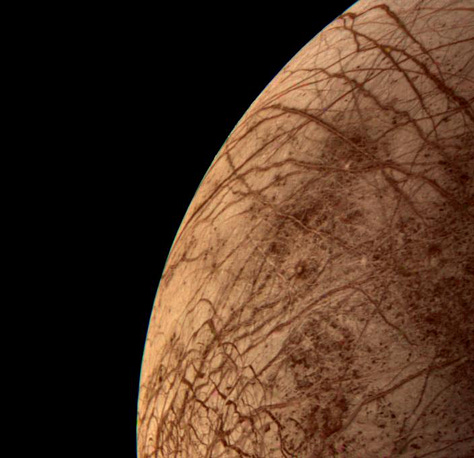
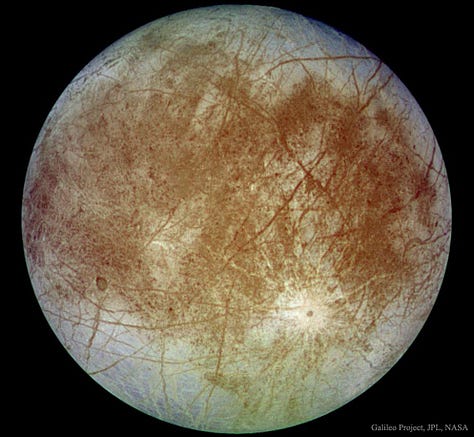
The Europa Clipper
After Galileo’s discoveries, the idea of sending a dedicated probe to Europa started to gather pace. At first an orbiting probe was suggested, one that would carry the instruments needed to peer through Europa’s icy shell and reveal the ocean underneath. But there was a big problem with this idea. Jupiter, it happens, is surrounded by energetic particles, and Europa lies in one of its strongest belts of radiation.
No spacecraft can withstand this radiation for long, and so an orbiter would essentially become a short-lived suicide mission. In its place, NASA briefly considered sending a big nuclear-powered probe, one that could dart between the moons of Jupiter and stay clear of the radiation belts. But after thinking about it for a bit, NASA realised the idea was not only incredibly expensive but also utterly insane, and quietly abandoned the project.
In its place, NASA eventually settled on the concept now known as the Europa Clipper. It will not orbit Europa, but will instead follow an elliptical path around Jupiter. For most of the time, this path will keep Clipper clear of Jupiter’s radiation belts. But once every few weeks it will fly inwards, pass close by Europa, and experience a burst of radiation.
This strategy will help the probe survive. NASA reckons it will get at least four years of work out of Clipper before it succumbs to the radiation, in which time it will make fifty close approaches to Europa. Some of these will be low, passing just twenty-five kilometres or so over its surface, and so will offer plenty of opportunity to study the moon in detail.
Though each pass will be short, in total the probe will probably be able to gather more observations in this way than a simple orbiter would. And since Clipper’s instruments can gather data faster than its radios can send it, the downtime between passes offers an opportunity to return as much information about the moon as possible.
These fly-bys, however, will not begin until the 2030s. Over the next six years the spacecraft will fly across the Solar System, following a route that takes it first to Mars and then onwards to the outer planets. It should arrive, if all goes well, sometime in early 2030. Even then, the probe still needs to fly past the moon Ganymede in order to enter the right orbit and align it for the first pass over Europa. If all goes to plan, that moment should finally come in March 2031.
Is Europa Habitable?
Clipper’s goal, once it arrives, is to find out if Europa is habitable. That’s not quite the same as finding life itself: Clipper will instead look at Europa’s surface and interior to work out if the processes and ingredients needed for life are there. It will not look for the signs of life, but it should be able to tell us whether life, having emerged from the dark, could go on to thrive there.
But this raises a hard question. What is it that life needs? What makes a world habitable? Life as we know it is based on liquid water, carbon, and energy provided by photosynthesis. But biology elsewhere may use other energy sources and base itself on other chemicals - ammonia, for example, might work in place of water. Perhaps, Sagan once speculated, creatures on alien worlds might strain our very conception of life, defying any easy categorisation.
Still, there are some places we can start. All life needs energy, and so must have access to an energy source. On Earth that is primarily the Sun, yet Europa’s oceans, buried under miles of ice, must surely endure an eternal night. But they are warm, heated by the moon’s interior as it flexes under the intense tides of Jupiter. This, in theory, could provide the energy life needs.
It also seems plausible that this flexing could drive volcanic vents on Europa’s seafloor, through which heat and chemicals might flow. We have found life around similar vents at the bottom of Earth’s oceans, life which is not in any way dependent on sunlight. If these vents exist on Europa, they are a promising place to look for living creatures.
Energy alone, however, is not enough. Life on Earth also needs water, something which seems to be abundant on Europa. Galileo’s measurements tell us it holds more water than all the oceans of Earth combined. But what’s unclear, so far, is how much of that is frozen, and how much is liquid.
To find out, Clipper is carrying a radar designed to peer through Europa’s surface. The radio waves it emits can penetrate ice, but are partially reflected by boundaries between ice and water. The bottom of Europa’s ice shell should thus appear as a bright band to this radar, allowing us to measure how far down the water lies. Once we know that, we can work out both how deep Europa’s oceans are and how much water they contain.
If Europa really has the deep oceans and interior warmth we think it does, then the prospects for life will start to look good. But to really assess the habitability of Europa we need to look more closely at those oceans. We need to find out what molecules are in them - and, therefore, what kind of chemistry might be brewing deep under the ice.
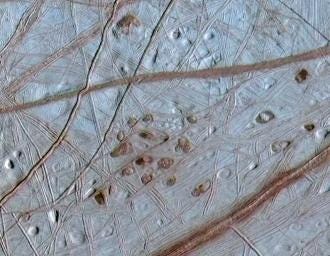
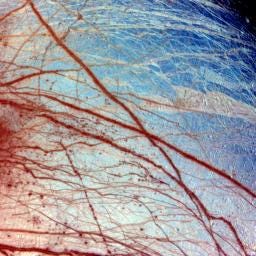
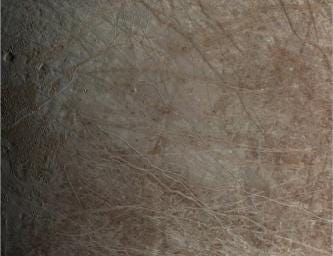
The Ingredients for Life
In November 2005, the Cassini probe captured images of plumes of water erupting from Enceladus, a moon of Saturn. Afterwards, Cassini flew directly through one of those plumes, sampled the gases it encountered, and found they contained water vapour, carbon dioxide, and other organic compounds. Later measurements found traces of all the elements needed for life as we know it: making Enceladus, like Europa, a potentially habitable world.
Since both Galileo and the Hubble Space Telescope have seen hints of such plumes around Europa, it is possible Clipper might one day fly through one and get direct evidence of the oceans below. But we are still uncertain if they really happen.
Europa’s ice is thought to be much thicker than Enceladus’, and water plumes should have a hard time breaking through it. But perhaps there are weak spots in the ice shell, formed by underwater volcanoes or from past meteor impacts. Or perhaps there are pockets of water within the shell, out of which plumes sometimes squirt.
Despite this uncertainty, Clipper is equipped to look for these plumes, and to sample one if it happens at the right time and place. And even if it doesn’t get that chance, it also has the instruments to measure Europa’s atmosphere and look for traces of chemicals spewed out by previous plumes.
Of equal interest is Europa’s puzzlingly smooth surface. Most worlds in the solar system are covered in the scars and craters of past asteroid strikes - our Moon is just one example of the usual terrain. Yet Europa isn’t. Something seems to have resurfaced the moon in the past few million years, and so erased this history of impacts.
We are not sure how this happened, but it seems plausible some kind of activity might be taking place. Earth’s surface, for example, is constantly reshaped by the motion of the continents, the force of the wind, and the flow of water. Europa might experience eruptions of water from its interior, exploding outwards in a strange form of volcanism and smoothing its surface.
The question is, however, whether this is currently happening. Europa’s orbit around Jupiter shifts over time, and it thus passes through periods where its interior is heated more strongly, and in which volcanoes erupt more frequently. Right now it seems to be in a quiet period, but that doesn’t mean the activity has died down completely.
Regardless, this all means there are probably times when Europa’s ocean makes it to the surface, and traces of it may thus be found there. Salts or other molecules on Europa’s surface could offer clues about the chemicals under the ice. Indirectly, then, their presence should tell us both about the prospects for life under the surface of Europa, and about the recent history of the moon.
Clipper will thus look for two things. First, it will search for signs of hotspots on the surface, places where the ice may have thinned and water could be erupting. And then it will measure the molecules and chemicals found on the surface, in the hope that they reveal the chemistry of its ocean.
Beyond the Clipper
Clipper, NASA often reminds us, is equipped to look for the possibility of life, but not for life itself. And as Sagan noted in 1993, a definite proof of life is hard to come by, even with a spacecraft passing just a few hundred miles away.
The biggest problem with Europa is its ice. Any life that does exist on the world is hidden away, buried under a shell a dozen miles thick and all but impenetrable to the instruments needed to look for life. Barring some miraculous discovery in a plume squirting from that interior, finding living beings is always going to be a challenge.
Clipper itself may survive a bit longer than NASA hopes, even if the radiation it is exposed to will certainly kill it before long. That extra time, if it gets it, should allow for more detailed observations of the moon, perhaps to follow up any interesting things its earlier mission finds.
But to look for life itself we’ll need another probe, and probably some kind of lander. Indeed, one goal of Clipper is to identify places that might make good targets for any future lander, and especially places where the ice is thinner than normal.
Yet even a lander, or a series of rovers akin to those deployed on Mars, would still struggle to find life. The surface of Europa is bathed in radiation, and even if the right chemicals are there, no life or probe is likely to survive long. What we really need is a way to get under the ice.
One idea suggests releasing radioactive probes on the surface. The heat they constantly emit will allow them to melt their way through the ice shell before plunging into the ocean. In principle they could send back signals by radio or cable to a waiting station on the surface, from which their data would be relayed back to Earth.
This, some scientists argue, should take place as part of an intensive campaign to explore Europa. It is probably the best place in the Solar System to look for life, other than Earth. And if we find life, no matter how simple, it would hint that living creatures are common across the galaxy. That would be an astonishing thing to learn.
All of that, though, will have to wait. Clipper will take half a decade to reach Europa, and work on a follow-up may not begin until the 2030s. Exploring Europa will be the work of decades, and it has only just begun.
Over the past year, the Europa Clipper science team has published a collection of articles in Space Science Reviews. These go into great detail about the science of Europa, the mission, its instruments, and what they might find. The collection is freely available at this link.
Read More
How Dust on the Ocean Floor Hints at a Recent Near-Earth Supernova
However big you imagine a supernova to be, the reality is certainly bigger. To put it one way, an exploding star can briefly outshine the combined light of every other star in a galaxy; to put it another, a supernova at the distance of Pluto would hit you with more energy than a hydrogen bomb exploding just outside your front door.



